- Home
- Deborah Harkness
The World of All Souls Page 26
The World of All Souls Read online
Page 26
Also known as Hertford Bridge, this raised walkway joins two parts of Hertford College over New College Lane and is a much-loved and iconic Oxford landmark. From here Matthew could watch, unnoticed, as Diana walked below him, heading back to her college.
Bridge of Sighs, New College Lane, Oxford OX1 3BL
New College Lane
No matter what I told myself in the quadrangle, my walk home was faster than usual. The gloom of New College Lane was a spooky proposition at the best of times.
New College Lane, Oxford OX1 3BL
New College
Fleeing from the warden’s lodgings, I turned toward my old refuge in the cloisters and walked among the pillars until my pulse stopped racing.
Diana Bishop’s alma mater, and her host institution during her research fellowship in England, New College is known for its well-preserved medieval garden, its Gothic cloisters, and the beauty of its buildings. Number 7 staircase, off the garden quadrangle, leads up to where Diana’s rooms were.
New College, Holywell Street, Oxford OX1 3BN
See also: ORGANIZATIONS: New College
All Souls College
A pair of ornate scrolled gates guarded his college as if it were Wonderland.
Matthew Clairmont’s august institution is the quietest of the Oxford colleges, despite its busy location off the Radcliffe Quad between Broad Street and the High, and it has frontage facing the Radcliffe Camera as well as High Street. Unless you are a scholar with permission to enter through the Codrington Library, you will have to use the High Street entrance. Walking through to the final quadrangle reveals Hawksmoor’s famous towers reaching for the sky.
All Souls College, Oxford OX1 4AL
See also: ORGANIZATIONS: All Souls College
Covered Market
I went shopping along the aisles of Oxford’s Covered Market. List in hand, I made my first stop at the butcher for fresh venison and rabbit, and then to the fishmonger for Scottish salmon.
Did vampires eat greens?
Oxford’s bustling Covered Market was originally opened at the end of the eighteenth century to bring all the city’s messy food stalls under one roof. It is still home to a range of traders, the majority of whom deal in delicious fresh food. It was the best place for Diana to find the quality produce she needed to cater to a vampire with a refined palate.
Covered Market, Oxford OX1 4AQ
See also: LIFESTYLES: All Souls Recipes
Christ Church Meadow and the Isis River
We walked in silence for a few minutes, wrapped up in the gray fog and the strangeness of being alone, witch and vampire.
Residents of Oxford will spend whole days walking through the meadow, wandering down to picnic on the banks of the Isis River and watch the boats go by when the weather permits. Walking toward the river soon takes you to one of the main towpaths: turning left on it takes you down past the university boathouses; going right leads to the stone bridge used by cars. Carefully crossing over the bridge and using this towpath will give you a different vantage point and allow you to carry on down past the boathouses opposite. Diana rowed this way, under Donnington Bridge, past the city of Oxford’s boathouse on the other bank, and to the Isis Farmhouse pub at a spot in the river known as Haystacks Corner.
Christ Church Meadow, Oxford OX1 1DP
I managed to get down the river, but the serenity of the outing had evaporated. Turning the boat in front of the Isis Tavern, I spotted Clairmont standing beside one of the pub’s tables. He’d managed to get there from the Donnington Bridge—on foot—in less time than I’d done it in a racing scull.
Here you can see the stretch of river that Diana was rowing down, with the Isis Tavern (now called the Isis Farmhouse), where she found Matthew waiting for her, on the right.
Isis Farmhouse, Haystacks Corner, The Towing Path, Iffley Lock, Oxford OX4 4EL
See also: LIFESTYLE: Rowing
Woodstock
The picturesque village of Woodstock, within easy distance of Oxford, is today known as the place where tourists have lunch before visiting nearby Blenheim Palace, as well as for its historical association with the craft of glove making. In the world of All Souls, this is where Matthew’s house, the Old Lodge, is located. The village is a wonderful example of a medieval town in the Oxfordshire countryside. Like Matthew, Diana is lucky enough to know it in both the Tudor and modern periods.
Long ago there was a royal palace in Woodstock, and the area was popular with members of the royal family who wanted to hunt and breathe some country air. Henry VIII was especially fond of the deer park there. Woodstock was less recreational for Elizabeth Tudor, who in 1554 was imprisoned in the palace by her sister Mary. The medieval palace is long gone, its stones and bricks used to build Blenheim, but Matthew’s local church, St. Mary Magdalene, can still be seen. The spectacular timbered ceiling will make you think you have timewalked to 1590, and you may hear the same bells that Diana did, tolling the hours.
St. Mary Magdalene Church, Park Street, Woodstock, Oxfordshire OX20 1UG
Sixteenth-century Woodstock as recorded in Gonçalves Manuscript 4890 (Diana’s commonplace book)
The Old Lodge
A two-story Tudor manor house was arranged around a central courtyard. Its bricks glowed in the illumination of powerful spotlights that shone through the branches of gnarled oak trees to light the face of the building.
In 1536, during the early dissolutions of the monasteries, Henry VIII rewarded Matthew for his services to the Crown by gifting him land that had been occupied by a religious house. Matthew was forced to tear down the monastery, and he built a house on the site of the ruins. As both a carpenter and a stonemason, Matthew chose not to use the stones of the old foundation for his house, believing that to do so would be sacrilege. Instead he built a massive half-timbered Tudor mansion in the middle of the Cotswolds. Its black-and-white façade sticks out like a sore thumb amid the warm Cotswold stone of the area’s architecture, but the de Clermonts have never been slaves to fashion.
Diana was stunned by Matthew’s beautiful Oxfordshire house when he first took her there for a yoga class. Looking at the real Tudor manor house that inspired the Old Lodge and grounds, it’s easy to imagine her reaction. The striking Speke Hall is located in the north of England, near Liverpool, rather than in the Cotswolds, and dates back to 1530. Its exterior and design, as well as the interiors of the wood-paneled Great Hall and the ornately carved bed in the Tudor Green Bedroom, conjure the Old Lodge’s atmosphere and presence. Speke Hall also has a priest hole (a common feature in that period of religious persecution), as well as a peephole in one of the bedroom’s chimneys, allowing occupants to spy visitors coming up the approach to the house.
I was an impressionable eight years old when I first visited Speke Hall. It has always been the Tudor house of my imagination, so I just had to have it for Matthew. In a move of authorial invention, I relocated it to Oxfordshire—even though the half-timbered architecture is not really characteristic of that region. Speke Hall is now operated by the National Trust, and the house and grounds are open to visitors, so be sure to drop in if you’re ever in the area!
The Old Lodge sixteenth-century floor plans, as recorded in Gonçalves Manuscript 4890 (Diana's commonplace book)
Speke Hall, the Walk, Liverpool, Merseyside L24 1XD
See also: DECORATIVE ARTS: The Old Lodge Parlor
Chipping Weston
Chipping Weston was the type of picturesque English village where novelists liked to set murder mysteries. It looked like a postcard or a film set, but it was home to several hundred people who lived in thatched houses spread out over a handful of narrow lanes.
When looking for a village to serve as a model for Chipping Weston, the home of daemon Timothy Weston, I discovered Weston-on-the-Green. It seemed meant to be! The medieval village has preserved many histo
rical sites, including the public stocks where residents were punished for their crimes. The model for Timothy’s house is a hotel, the Manor at Weston-on-the-Green, dating back to the early sixteenth century (with various additions and renovations carried out over the years).
The Manor at Weston-on-the-Green, Northampton Road, Oxfordshire OX25 3QL
Scotland
Cadzow Lodge
Little about this part of Scotland was soft or inviting, and its forbidding beauty suited his present mood. He downshifted through the lime alley that had once led to a palace and now led nowhere, an odd remnant of a grand life no one wanted to live anymore. Pulling up to what had been the back entrance of an old hunting lodge, where rough brown stone stood in sharp contrast to the creamy stuccoed front, he climbed out of his Jaguar and lifted his bags from the trunk.
Hamish Osborne’s Scottish hunting lodge, Cadzow, was inspired by Chatelherault Country Park in Hamilton, Scotland. Built in 1732 as a hunting lodge for the Dukes of Hamilton, Chatelherault was designed by the neoclassical architect Robert Adam (1728–92) and is all that is left of a once-vast estate. The remains of the tree-lined avenue that Matthew drove down once linked the hunting lodge to the famously grand and luxurious Hamilton Palace, seat of the Hamilton family, which was eventually demolished in 1921. The ruins of sixteenth-century Cadzow Castle can still be seen in the grounds of Chatelherault Country Park, overlooking the gorge of the river Avon. The nearby town of Hamilton was also once named Cadzow, but the name was changed in the mid-fifteenth century in honor of the 1st Lord Hamilton.
Matthew isn’t a fan of Hamish’s gaudy “ill-conceived folly,” with its grand and drafty dining room, but to Hamish the lodge’s lavish design and impracticality are the perfect sign of how far he has risen from his Glaswegian roots. Matthew and Hamish have spent many contented evenings here drinking wine and whiskey and playing chess.
Chatelherault Country Park, Carlisle Road, Ferniegair, Hamilton ML3 7UE
Shadow of Night Outtake
The Voyage to France
Five of us set out from the Old Lodge in Saturday’s predawn darkness. Our early departure was timed to take full advantage of the meager seven hours of daylight between sunrise and sunset. Riding a large black stallion named Brutus, Matthew issued final orders to the staff while Walter, Gallowglass, and Pierre completed their own preparations for the journey. My chestnut mare had been tacked up with a sidesaddle for propriety’s sake. I sat on it gingerly and hoped for the best. Ysabeau had dared me to ride sidesaddle at Sept-Tours, and I thanked Matthew’s mother silently for doing so while my horse fidgeted impatiently in the courtyard. I managed to stay on her back despite the slip of my woolen skirts against the leather-and-velvet saddle, all the while thinking longingly of my modern black riding britches and boots.
Once clear from the boundary of Matthew’s estate, we took the muddy track that would one day become the smoothly paved, considerably wider Woodstock Road, and turned toward the south coast of England. En route we passed lumbering wagons as well as people traveling on smaller, tired animals. Matthew spared no expense in acquiring fresh horses from the inns stationed conveniently along the way. For Elizabethan spies the key to speed was a ready supply of good horseflesh rather than a fast car.
For the first part of the journey, I was delighted to be outdoors and seeing more of sixteenth-century England. The countryside looked as I had expected it would: small clusters of houses and barns cobbled together from a combination of stone, plaster, wood, and thatch; gray plumes of smoke rising from chimneys and autumn bonfires; animals set out to pasture; and people going about their daily tasks. But I reveled in the small details of life that history books seldom mentioned: the flurry of birds entering and exiting dovecotes; the cries of children as they gleaned the walnuts that had been shaken from the trees in Thursday’s storms, their hands stained from contact with the hulls; the dogs that roamed freely and kept the sheep, cows, and nut-collecting children safely corralled; the women who were taking advantage of today’s break in the rain to do laundry.
By noon we had traveled nearly thirty miles, but there were as many still before us. After climbing onto my third horse, I could muster no further interest in the passing sights and sounds. I was aware only of crushing fatigue and the bizarre sensation that the earth was moving underneath me even when I was standing still. When we changed horses yet again, Matthew insisted that I rest and have some food. Though nothing was said, it was clear that I was slowing us down.
“Let me ride astride,” I murmured to Matthew, working my gloves off chilled fingers. “We could go faster if I felt more secure on my horse.”
“It’s too risky,” Matthew said, casting a look from the window of our private room into the inn’s busy courtyard. “We’ve already drawn attention by traveling in such a large group. A woman riding astride would suggest there was an emergency that put speed over decorum.” I was about to point out that we were in precisely that situation when Raleigh intervened.
“There’s little hope of making Portsmouth by nightfall,” Walter observed quietly, handing me a beaker of wine and pointing me to a roasted capon that was steaming on the table. As my stomach was churning with exhaustion and motion sickness, I lowered myself into a nearby chair instead, my hips and thighs protesting.
“Then we will change our plans,” Matthew said curtly, his eyes still on the courtyard below.
Walter’s prediction was realized at the outskirts of Winchester when I toppled from my horse. Had I not been traveling with three vampires, it would have been a nasty fall. Instead Gallowglass caught me, Pierre kept my horse from bolting, and Matthew carried me to our lodgings for the night. The last thing I remembered clearly was the blinking of lamps in the dusk and the spires of the cathedral rising from the chalky soil of the downs.
When my eyes opened, I was lying in a comfortable bed. I still felt the sensation of movement, rather like the one I had after a long row on the river, when despite being on dry land I could still feel the run of water under the boat’s hull. Matthew waited beside me. Two men in somber black habits stood nearby, large crosses worked in silver thread over their hearts. Startled by the sight, I tried to get up.
“Everything’s all right,” Matthew said, carrying my hand to his lips and kissing the ring on my third finger.
“Where are we?” I asked after I’d fallen back onto the pillows.
“You are at the Hospital of the Holy Cross, Madame de Clermont.” A middle-aged man at the front of the huddle stepped forward. I was surprised that he knew Matthew’s true identity, as well as our relationship. Clearly I still didn’t understand the rules of being a spy’s wife. “I am Robert Bennett, the master of the hospital.”
“A hospital. How long have I been here?” I grabbed for Matthew’s hand. Sixteenth-century hospitals were places for incurable complaints and last resorts for poor souls who couldn’t afford any other treatment.
“Not yet thirty minutes,” Matthew replied, smoothing my hair with his free hand. “You collapsed.”
“I’ve never collapsed!” My protest was less effective from a prone position, and I struggled to sit up again. Matthew’s hands on my shoulders kept me from doing so.
“You did a damned fine imitation of it, then,” Walter said sharply. Bennett raised an admonishing finger. “My apologies, Robert.”
It was evident after listening to the next twenty minutes of conversation that the Hospital of the Holy Cross was part almshouse, part home for indigent travelers, and entirely within the control of the Knights of Lazarus. I wondered why Walter’s orders had been obeyed immediately, producing rooms far from the other guests and the promise of a hot bath later to ease my sore muscles. The answer lay in the signet on Walter’s little finger, bearing the outlines of Lazarus and his coffin.
“So you’re a knight, too,” I said weakly as Walter and Matthew helped me out of bed.
“Yes,�
� said Walter tersely.
“And you must outrank Hancock.” Walter had effectively silenced him at the Old Lodge. Raleigh pulled out a chair for me in lieu of a reply. “What about Gallowglass?”
“I outrank everyone in this room, madam, with the exception of your husband,” Raleigh cautioned. “And that includes you. So be quiet and eat what Brother Barnabas has prepared for your supper.” Brother Barnabas, who waited patiently by the table with a bowl, smiled at me encouragingly.
“You have no authority over me,” I shot back. “Exactly what is your role in the de Clermont family’s business, Walter?”
Over my head, Raleigh’s angry blue eyes met Matthew’s. “Is she always like this?”
“Usually,” Matthew said dryly. “It takes some getting used to, but I rather like it. You might, too, given time.”
Walter snorted but answered, “I command the brotherhood in England.”
“So you’re one of the order’s eight provincial masters and report directly to Philippe,” I said thoughtfully. “I wondered for a moment if you were the ninth knight.” The ninth knight was a mysterious figure in the order, his identity kept secret from all except those at the very highest levels.
Raleigh swore so vehemently that Brother Barnabas gasped.
“That’s more than enough talk of the brotherhood for one evening,” Matthew said, drawing me toward the fire in an attempt to distract me with food.

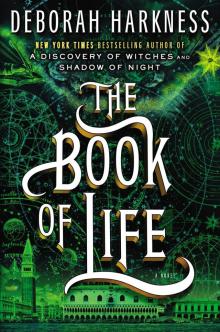 The Book of Life
The Book of Life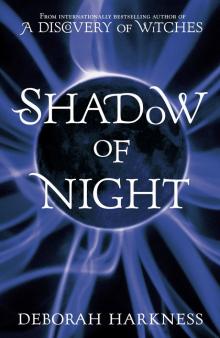 Shadow of Night
Shadow of Night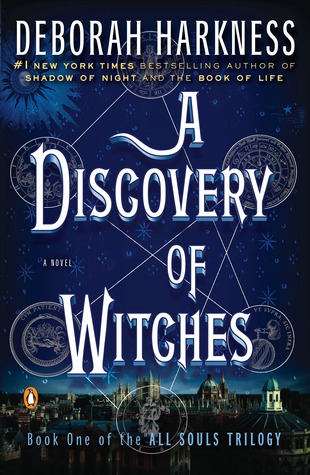 A Discovery of Witches
A Discovery of Witches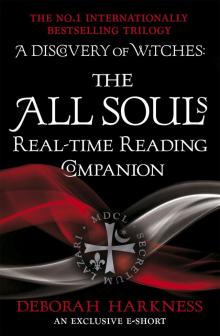 The All Souls Real-Time Reading Companion
The All Souls Real-Time Reading Companion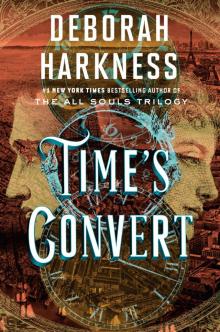 Time's Convert
Time's Convert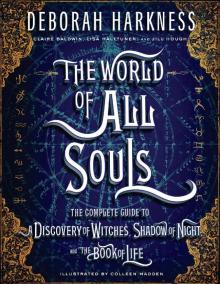 The World of All Souls
The World of All Souls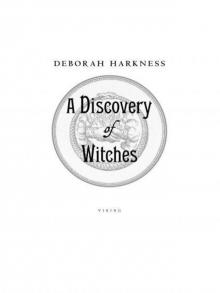 A Discovery of Witches: A Novel (All Souls Trilogy)
A Discovery of Witches: A Novel (All Souls Trilogy) Shadow of Night: A Novel
Shadow of Night: A Novel